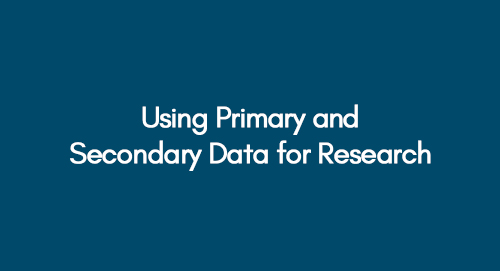
Crafting an Academic Report: An In-Depth Guide for Students
January 10, 2023What are the Similarities Between Qualitative and Quantitative Research?
January 19, 2023Primary and secondary data research are crucial components of academic inquiry and decision-making processes. While primary data involves gathering firsthand information directly from the source, secondary data entails utilizing existing data collected by others for a different purpose.
Introduction
Primary and secondary data research are two different ways of gathering information for a study. Primary data is collected firsthand by the researcher, while secondary data is already available and collected by someone else. Understanding the differences and knowing when to use each type can be helpful for researchers to conduct their studies effectively.
What is Primary Data?
Primary data is data that is acquired directly from the source without the use of any existing sources. It is typically collected specifically for a study endeavor and may be released openly for other research purposes.
Reviewing Examples of How to Use Primary Data in Your Dissertation
Primary data is frequently credible, authentic, and objective because it was gathered with the intent of addressing a specific study problem. It is worth emphasizing that due to the cost of implementation, primary data is rarely gathered.
Examples
Primary data is frequently obtained by firms during market research, product research, and competitive analysis. This information is gathered directly from its source, who in most cases are existing and prospective consumers.
What is Secondary Data?
Secondary data is information that has already been acquired by someone else but has been made available for use by others. They are normally the main data until they are used by a third party.
Secondary data is frequently freely available to academics and users since it is widely disseminated. However, this implies that the data is typically generic and not customized especially to the researcher's needs, as primary data is.
For example, when performing a research thesis, scholars must reference previous works on this topic and include their findings in the literature review. Other secondary material, including definitions and theorems, are added to the thesis to be correctly referred to and cited.
Trade magazines, government statistics, journals, and other secondary data sources are prevalent. Most of the time, these sources cannot be trusted.
Explore the primary data sources below to understand where information directly originates from.
Primary Data Sources
A primary source is evidence that was obtained directly or firsthand concerning an event, object, individual, or work of art. Primary sources are the original materials on which additional research is based, allowing students and other researchers to get as near to what truly happened during a specific event or period as possible. Published materials can be deemed primary resources if they are from the chronological period in question and were written or produced by someone with firsthand knowledge of the event. Primary materials frequently represent the individual perspective of a public spectacle. Primary sources may be written or oral (sound, pictures, artifacts, etc.). Primary sources in scientific study convey original thought, report on discoveries, or give new knowledge.
There are various approaches to collecting primary data. It describes the tools used in primary data collection, some of which are highlighted below:
1. Interviews
An interview is a data-gathering procedure that involves two sets of people: the interviewer who asks the questions and collects the data) and the interviewee (the subject that is being asked questions). During an interview, questions and responses may be oral or verbal, depending on the circumstances.
The two methods for conducting interviews are one-to-one interviews and telephone interviews. A face-to-face interview requires an interviewer or a group of interviewers to ask questions of the interviewee.
It can be direct or indirect, structured or unstructured, and so forth. Some of the equipment used in conducting face-to-face interviews include a notepad or recording device to take notes on the conversation—this is critical owing to the forgetfulness of humans.
Telephonic interviews, on the other hand, are conducted over the phone using regular voice conversations or video chats. The two parties concerned may decide to conduct interviews using video conversations such as Skype. This requires a mobile phone, laptop, tablet, or desktop computer with an internet connection.
2. Surveys & Questionnaires
Surveys and questionnaires are two related strategies for gathering primary data. They are a series of questions recorded or written down and distributed to the study's sample for responses.
Following the completion of the appropriate responses, the survey is returned to the researcher for recording. It is recommended to conduct pilot research in which specialists fill out questionnaires to examine the weaknesses of the questions or methodologies utilized.
There are two types of surveys used for data collection: online surveys and offline surveys. Online surveys are conducted utilizing internet-enabled devices such as mobile phones, PCs, tablets, and so on.
They can be distributed to responders via email, websites, or social media. Offline surveys, on the other hand, do not need an internet connection to be completed. A paper-based survey is the most prevalent type of offline survey. However, there are offline surveys, such as Formplus, that may be completed with a mobile device without an internet connection.
This type of survey is known as an online-offline survey since it may be completed offline but must be submitted over an internet connection.
3. Observation
The observation method is commonly employed in behavioral science research. The researcher uses observation as a scientific instrument and data collection approach. Observation as a data-gathering tool is typically prepared in advance and subjected to checks and controls.
There are several techniques to the observation method, including organized and unstructured approaches, controlled and uncontrolled approaches, and participant, non-participant, or disguised approaches.
The structured and unstructured approaches are distinguished by thorough characterization of subjects of observation, observer style, circumstances, and data selection. A structured observation method meets this need and vice versa.
A controlled or uncontrolled method denotes whether the research was conducted in a natural context or according to predetermined plans. When conducted in a natural situation, an observation is uncontrolled; yet, when conducted in a laboratory, it becomes regulated.
Before hiring a new teacher, academic institutions may request a sample teaching class to assess the teacher's abilities. The assessor attends the class and observes the instruction, becoming a participant. The evaluation may also choose to observe from outside the classroom and so become a non-participant. An evaluator could also be asked to remain in class and disguise himself as a student to conduct a disguised observation.
4. Focus Groups
Focus groups are made up of two or more persons who have comparable or shared features. They are looking for open-ended ideas and suggestions from participants.
Because the data is acquired directly from the participant, a focus group is a key source of data collecting. It is frequently used in market research, where a group of market users converses with a research moderator.
It is similar to interviews, except instead of questions and answers, it features talks and interactions. Focus groups are less formal, with participants doing the majority of the discussion and moderators overseeing the process.
5. Experiments
An experiment is a planned study in which researchers attempt to comprehend the origins, effects, and procedures in a certain process. This form of data collecting is normally monitored by the researcher, who decides which subjects are employed, how they are grouped, and how they are treated.
The subject to be considered is chosen by the researcher at the initial step of the experiment. As a result, some acts are performed on these people, while the researcher records primary data comprising of the actions and reactions. They will then be investigated, and a decision will be made based on the results.
Sources of Secondary Data
Secondary data sources include books, personal sources, magazines, newspapers, websites, government records, and so on. secondary data is known to be more readily available than original data. Using these sources involves relatively little investigation and manpower.
With the development of electronic media and the internet, secondary data sources have become more reachable. Some of these resources are highlighted below.
1. Books
Books are among the oldest methods of data collection. Books are now available on any topic you can think of. When conducting research, all you have to do is search for a book on the topic under consideration and then choose from the available library of books in that field. Books, when carefully chosen, are an authentic source of accurate data and can aid in the preparation of a good literature review.
2. Publication Sources
There are numerous published sources available in multiple study areas. The validity of the data supplied by these sources is mostly determined by the writer and publication business.
Published sources might be printed or electronic, depending on the situation.
3. Newspapers
In most circumstances, information obtained from a newspaper is highly reliable. As a result, it is among the most reliable sources of secondary data.
Newspaper data is typically more political, economical, and educational than scientific. As a result, newspapers are not the ideal source of scientific data.
4. Websites
Because most information posted on websites is unregulated, it may not be trusted when compared to traditional options. Researchers can, however, rely on select controlled websites that exclusively give legitimate data.
The majority of these sites are either government or business agencies that are paid data collectors.
5. Blogs
Blogs are among the most common internet data sources, and they may be less genuine than web pages. Nowadays, almost everyone has a blog, and many individuals utilize these sites to drive traffic to websites or make money via paid advertisements.
As a result, they cannot always be trusted. For instance, a blogger may write positive things about a business because the producer paid him or her to do so, even if the statements are false.
6. Diaries
Because they are personal records, researchers rarely use them to collect data. Also, diaries are typically personal, except people now publish public diaries documenting particular events in their lives.
7. Government Records
Official records are a valuable and reliable source of secondary data. They contain data that can be used in advertising, business, arts, and social science studies.
Census data, healthcare data, educational institute records, and so on are examples of these records. They are typically gathered to aid in proper project planning, funding allocation, and project prioritization.
8. Podcasts
Podcasts are steadily becoming more popular, and many people use them as an alternative to radio. They function similarly to digital radio channels and are gaining popularity.
Typically, information is shared throughout podcasts, and listeners can utilize it to collect statistics.
- Other data collection sources include:
- Letter
- Records from the public sector
Now let us discuss briefly the advantages of Primary data
Advantages of Primary Data
Primary data has its advantages, such as being specific to your research needs because you collect it yourself. It's also fresh and up-to-date since it's gathered firsthand.
1. More Accurate
Individuals investigate and produce primary data, providing special attention to each of the topics they intend to ask. People depend on their data more than they do on the data of others. Individuals who work on it could also make assessments. As a result, data becomes more legitimate and accurate. It is also more trustworthy than secondary data.
2. Updated Information
The information produced is current. No one else's data has been used to create information, which keeps the data up to date, and folks depend heavily on what is more up-to-date and recently produced. Primary data is typically collected by a survey or personal interaction, ensuring that the information gathered is accurate and up to date.
3. More Data Control
Because the person surveying using a questionnaire or any other design may manage the data, he has control of the entire survey. He can change or manipulate the survey to make it more significant. The expert may also face difficulties because target respondents may not easily understand the purpose of the survey, thus a little manipulation might help them receive the right feedback.
4. Privacy is Protected
The expert who oversees the survey activities protects the confidentiality of the data. It is self-evident that when a small group of people is in charge of the entire survey, confidentiality is kept among them to avoid leaking ideas.
5. The Intended Problem is Addressed
Data collectors develop questionnaires and sometimes conduct interviews with members of the targeted group to collect data. Also, the issue is addressed so that, with the right feedback, it can be brought to light and fixed. In this approach, the program may be made more productive, and problems can be dealt with more readily.
6. Data Understanding is Improved
The data collected through various designs and methods are made simple and easy to grasp so that anyone interested in data can readily understand it at a look. It is also more beneficial if the feedback is valid and accurate.
Disadvantages of Primary Data
The following are the disadvantages of primary data.
1-Time-Consuming Process
The survey organizer and method employed may take a long time to obtain data from raw sources. Secondary data is information gathered from other sources. As a result, it requires less time. Because it takes time, it sometimes delays fixing the issue in the surrounding area.
2- Costly
The survey is both time-consuming and costly. Experts must go to locations and use expensive equipment to acquire data. Also, after receiving input, correct documentation is essential, which must be handled carefully and at a high expense.
3- More Labor is Required
Mostly in the case of primary data, more labor is required because one individual cannot conduct a survey or gather data on himself or herself alone. Furthermore, the number of individuals necessary is greater, and they must be paid once their work is completed.
4- The Survey must be Simple and Easy to Comprehend
Only if the questionnaire is simple and easy to understand will the researchers receive accurate and valid feedback. The researchers must create a collection of example surveys in such a way or utilize a method or methodology that allows people to easily interpret it; otherwise, the feedback given will be erroneous.
5- Feedback may be Defective
We have already established that if the researchers' technique is not proper or accurate, the feedback generated will be faulty or erroneous. As a result, appropriate actions and maintenance are required to ensure that the feedback data supplied is authentic.
6- An Expert is Required for the Evaluation
The methodology for gathering data, procedure, and analysis must be performed by an expert because only an experienced person can make the entire research relevant by offering facts and information. The researcher or a professional performs the majority of the analysis based on the problem discovered.
Advantages of Secondary Data
Below are the advantages of secondary data.
1- Simpleness of Use
Secondary data are widely available. The Internet has changed the way secondary research is done. You can now access a multitude of information simply by clicking.
2- Low-Cost or Free
The majority of secondary research is either fully free or very cheap to use. It not only saves money but also time. Secondary research, as opposed to primary research, which needs you to plan and carry out the complete primary study technique from the beginning, allows you to acquire data without investing any money.
3-Time-Saving
As the preceding benefit demonstrates, you may conduct secondary research rapidly. A data source can occasionally be found with a few Google results.
4- Allow you to Gain New Insights from the Previous Study
Reanalyzing old data may result in unexpected unique ideas and points of view, as well as new relevant findings.
5- A Follow-up Investigation
Secondary data enables longitudinal analysis, which signifies that the investigations are carried out over a long period. This could help you identify specific trends. Secondary data from many years ago just a few hours ago is also available. It allows you to compare information over time.
6- Anyone Can Acquire the Information
Those who are unaware of the various data collection processes can conduct secondary data research. It is practically open to everyone. A massive amount of secondary data from numerous sources. It is the most complete source of information available on a wide range of topics and sources.
Disadvantages of Secondary Data
The following are the disadvantages of secondary data.
1- Not Tailored to Meet Your Needs
Secondary data is not specific to the researcher's needs because it was acquired for another reason in the past. As a result, secondary data may be untrustworthy for your immediate needs. Secondary data sources can provide a wealth of information, but quantity does not always imply relevance.
2- You do not Influence Data Quality
Secondary data may be of poor quality. The source of the information may be suspect, especially if it was obtained via the Internet. If you rely on secondary data for data-driven decision-making, you must assess the information's reliability by learning how it was gathered and evaluated.
Differences Between Primary and Secondary Data
The following are the differences between primary and secondary data.
1. Types of Data
Primary data contains recent data, whereas secondary data contains old information. Researchers have access to the most recent data when conducting the study, it this is not always the case with secondary data.
To conduct research, Secondary data must rely on original data gathered in the past. In some cases, the scientist may be lucky to collect data close to the period of research.
As a result, the level of mismatch between secondary and most recent data is lowered.
2. Process
Primary data gathering is typically difficult for researchers, however, secondary data collecting is straightforward. This is because primary research is typically longitudinal. As a result, researchers must dedicate significant time to doing research, collecting data, and analyzing the findings. This data can be obtained and analyzed in a matter of hours when conducting secondary research.
For example, a corporation may invest significant time in determining the market size for transportation companies interested in entering the ride-hailing sector. This information will be used by a prospective buyer to assist him in determining whether or not to invest in the sector.
3. Availability
Primary data is provided in its raw form, whereas secondary evidence is available polished. In other words, secondary data is usually simply presented to the public that a layperson can comprehend, but primary data is usually raw and must be explained by the researcher.
Secondary data is in this format because it was previously broken down by researchers who gathered primary data from the ground up. The public availability of Thomson Reuters annualized reports is one notable example.
Considering the example of Thomson Reuters, when he first collects this data, it is typically raw and difficult to understand. They make the data's results easier to understand by presenting them with graphs, charts, and written explanations.
4. Data Collection Instruments
Surveys and questionnaires can be used to collect primary data, while the library, bots, and other tools can be used to collect secondary data. The differences between these data-gathering tools are obvious, and they can be utilized interchangeably.
When gathering primary data, researchers look for an instrument that is simple to use and collects trustworthy data.
5. Sources
Surveys, observations, experiments, questionnaires, focus groups, interviews, and so on are examples of primary data sources, whereas secondary data sources include books, journals, articles, web pages, blogs, and so on. These sources explicitly differ, and there is no overlap between primary and secondary data sources.
Primary data sources necessitate a strong commitment from researchers as well as engagement with the subject of study. Secondary data, on the other hand, does not necessitate interaction with the topic of investigation.
In most circumstances, secondary researchers have no involvement with the research subject.
6. Specific
Primary data is always tailored to the researcher's requirements, whereas secondary data may or may not be tailored to the researcher's requirements. It is entirely dependent on the type of data that the researcher was able to obtain.
Secondary researchers may be fortunate to have access to data tailored specifically to their needs, which is not always the case. A market researcher, for example, examining the purchasing power of people from a specific community may not have access to the subject population's data.
Alternatively, there may be data available for another community with a similar standard of life to the subject locality.
7. Advantage
Primary data has the advantage of being legitimate, detailed, and up-to-date, whereas secondary data is inexpensive and time-consuming.
Primary data is particularly trustworthy because it is usually objective and obtained straight from the source. It also provides more up-to-date information on a research topic than secondary data.
Secondary school, on the other hand, is reasonably priced, making it simple for people to conduct secondary research. It doesn't take long, and the majority of secondary data sources are free to use.
8. Disadvantage
The expense and time spent on data collecting are disadvantages of primary data, whereas secondary data may be old or useless. Because of the methods involved in conducting primary research, primary data is expensive and time-consuming.
When actively interviewing research respondents, for example, one or more professionals may be required, including the interviewers, videographers who will film the interview in some situations, and those participating in the interview preparation. Aside from the time commitment, the cost of doing so may be relatively considerable.
Secondary data could be out of date and ineffective. Researchers must wade through irrelevant data before reaching the material pertinent to the research aim.
9. Accuracy and Reliability
Primary data is more accurate and dependable, whereas secondary data is less accurate and reliable. This is primarily because secondary data sources are unregulated and vulnerable to human prejudice.
An excellent example of this is business owners who pay bloggers to write positive product evaluations to get more customers. This is not the case with primary data gathered by the researcher himself.
When obtaining primary data for the study, one of the researcher's goals will be to collect accurate data to reach the right findings.
10. Cost-Effectiveness
Primary data is very expensive, whereas secondary data is inexpensive. When working on a tight budget, researchers should use secondary data and then analyze it to identify new trends.
In reality, for one study, a researcher may use both primary and secondary data. This is usually highly recommended when the existing secondary data does not fully fulfill the research goals.
As a result, a minor extension of the accessible data will be performed while saving money. For example, a researcher might need a market study from 2010 to 2019, but the accessible studies only go up to 2018.
11. Collection Time
The time required to acquire main data is typically lengthy, whereas the time required to collect secondary data is typically brief. The basic data collection procedure can be lengthy at times.
As a result, researchers may need to spend some time observing the research subject while collecting vital data. For example, while studying the behavior of a group of people or a certain animal, researchers must monitor them for an extended period.
Secondary data, on the other hand, can be gathered in minutes and processed to dead ends in far less time than primary data. Secondary data may take longer to obtain in some uncommon circumstances, especially when collecting fewer data, due to the difficulty of consulting numerous data sources to find the relevant data.
Which Data is Less Costly and Less Time Consuming
Both primary and secondary data have business and research applications. They may, however, differ in terms of how they are collected, used, and analyzed.
The most typical disadvantage of primary data is its high cost, which is not the case with secondary data. Secondary data, on the other hand, has concerns with legitimacy.
12. Limitation of Primary Data
The limitation of primary data is the money and effort spent on data collection, whereas secondary data may be erroneous or irrelevant. Primary data is expensive and time-consuming due to the evident procedures associated with conducting primary research.
13. Primary Data and Secondary Data in Statistics
Primary data in statistics and research is first-hand information acquired for a clear objective, such as survey results. Secondary data refers to information that is already available in another location, such as a diary, company records, or the Internet.
Conclusion
When conducting research, it is critical to analyze the available data options to guarantee that the appropriate type of data is used to reach a feasible conclusion. However, a thorough understanding of the many data formats, similarities, and distinctions is essential.
Both primary and secondary data have business and research applications. They may, however, differ in terms of how they are collected, used, and analyzed.
Get 3+ Free Dissertation Topics within 24 hours?



























